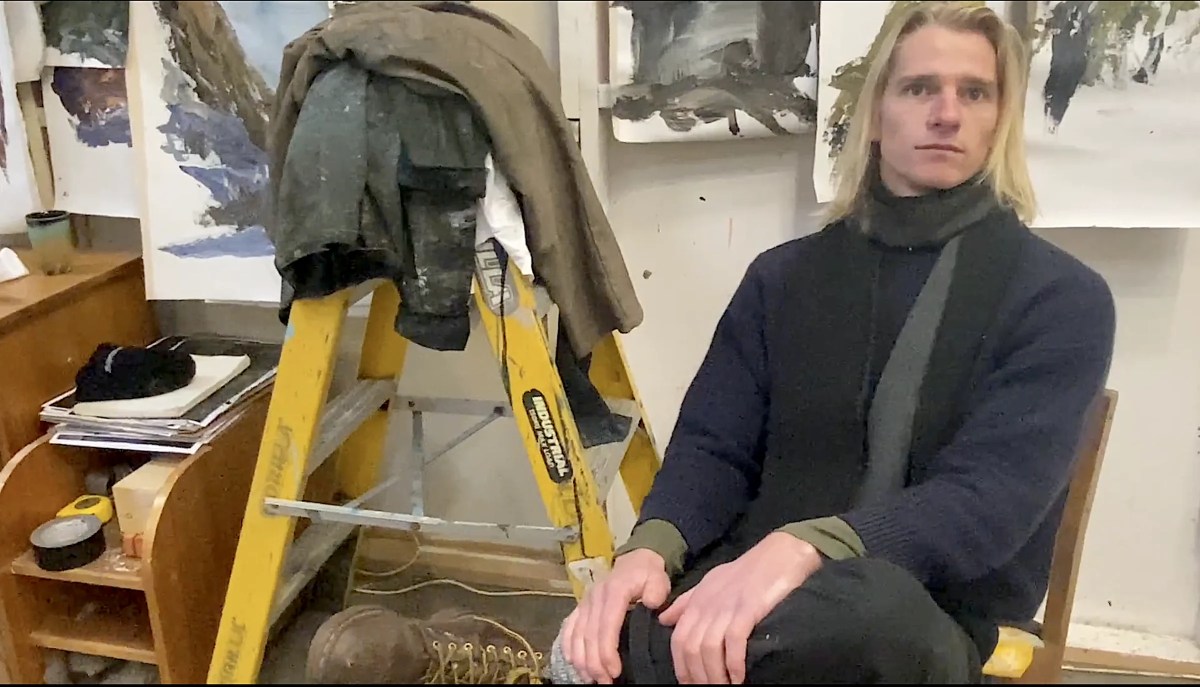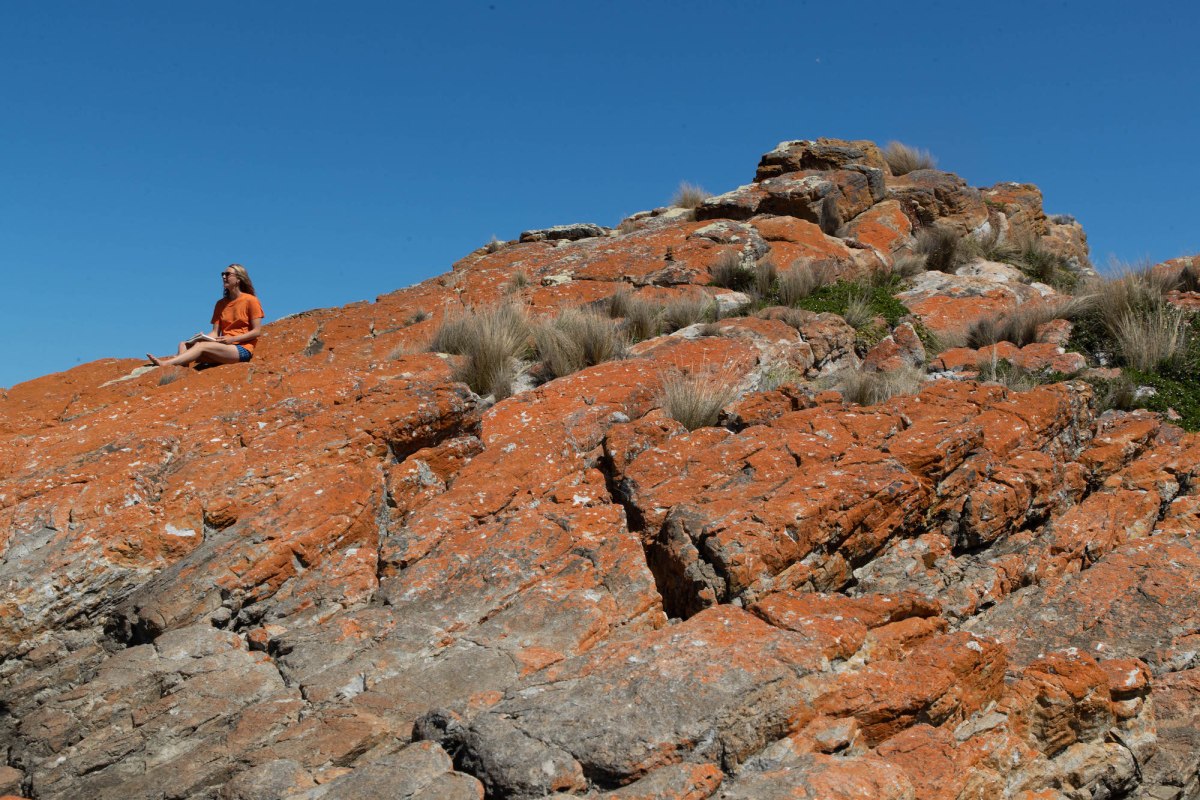Earlier this month, artist Zoe Grey was awarded the 2024 Hadley’s Art Prize. It was not only affirmation for the artist in her late twenties, but its $100,000 winnings will allow her to build a new studio – further entrenching her commitment to making in Tasmania.
Read: I’m an artist in my twenties, and I don’t want to leave Tasmania
Speaking with Grey, ArtsHub learns she will use her prize winnings to build a studio in the remote town of Marrawah – six hours from Hobart on the north-west coast – effectively making her studio practice more “isolated”.
During our visit to Hobart, ArtsHub visits the shared space Good Grief Studio in downtown Hobart, where Grey currently shares a studio with 13 other artists.
She explains that she is inspired working alongside fellow artists. ‘There is an amazing community of artists here in Tasmania, who are really supportive and champion each other. That is a beautiful thing, and we are lucky to have that.’
Also painting out of the collective studio, is fellow Hadley’s Art Prize Finalist, Harrison Bowe. He tells ArtsHub, ‘When I was younger it was so stagnant – it was hard to get things going. But it’s much better now.’
In contrast, Meg Walch has often done it alone. She lived overseas for 20 years, before returning to Hobart, where she grew up. ‘We came back thinking we would live half the year in Europe, but it doesn’t work out that way if you have a kid or a job,’ she says.
Walch suggests that Tasmania ‘allows you to thrive in a different way’. She continues: ‘I have a different life here [as an artist], one that I couldn’t have in other places. But every other year I am about to quit; I am just being very honest about that.’
To go, or not to go
Photographer and podcaster Sarah Rhodes moved to Tasmania from Sydney seven years ago, to be closer to family. Regarding the move, she tells ArtsHub: ‘I speak about this with my friends quite a lot. My career has really done a lot better since I’ve moved. And I would say it’s because of the natural landscape.’
She continues: ‘The environment is very stimulating here, and there are a lot of possibilities – it’s a microcosm, this island, for many of the world’s big issues, and it’s very accessible to explore those ideas.’
Having only ever lived in Tasmania, Bowe is also driven by the environment. ‘Before I became part of that scene, and for someone my age making art, you usually had to move to the mainland.’

Bowe admits that he does think about moving sometimes. ‘I do want to branch out. You do have to get off the rock. But “where?” is the interesting one – it has to have a good coastline. Here, I find myself with a lot of places to explore and work, and make work.’
Bowe paints the landscapes he walks through – and those walks often last several days, even weeks. ‘I do like a good walk,’ he adds.
He says that the changing cultural landscape in recent years has had a big impact on him staying in Hobart. ‘There is a definite shift in the scene, thanks to things like Hadley’s Art Prize and Mona (Museum of New and Old Art), which has played a big part in that – you can’t deny it.’
Coming from a more established career position, Walch says the dynamic of the Tasmanian art scene is a bit more complex. ‘People attribute the boom in creativity to Mona and that is not the case at all. Sure, Mona has changed things, but there was always a body of artists. It has been a great place of creativity, and Mona had nothing to do with that.’
Walch says she grew up in a Tasmania that was very different to what it is now. ‘I spent my whole youth studying art and trying to get out of Tasmania. I did the backpacking grand tour to see all the museums with the interesting art that we had been weaned on.’
Her big break came when she was awarded a Samstag Travelling Scholarship. ‘That was the beginning of my life,’ she says. She moved to the US to give her career a cracker go. But she tells ArtsHub it was very difficult. ‘Advanced capitalism is very different from capitalism that we know and, the longer I lived there, I saw how different the culture was – that was a mind f**k.’
The role of real estate in artist’s choices
‘It was the right time to return, because I wanted my own studio,’ Walch tells ArtsHub.
She bought an old boat building shed from the 1930s and converted it. ‘It had a dirt floor when I got here,’ she says. ‘Tasmania was the only [place] I could afford, but it is not the case any more.’
She says real estate and gentrification are also shaping the cultural landscape. ‘Like all great cities that artist flock to when they are cheap – New York and Berlin – it’s because the rents were low and cost of living easy.
‘My first share house in Tasmania was $15 a week – on a beach! – and you could make art and live on not very much money. I really think that is what grew Tasmania into a great place for artists,’ says Walch. ‘But that has changed with the climate and the COVID migration here. And, unfortunately, my son will never be able to afford to buy a house here now.
‘I fear the creativity, or the groundswell of it, will go because of that gentrification,’ adds Walch.
Bowe is also worried about mainland pressures on property in Hobart. ‘Once this goes, there’s no other option in the city,’ he says of the collective studio space.
The challenges of isolation

While the landscape inspires and offers connection for artists such as Grey and Bowe, for artist Walch the allure of Tasmania has been cheaper property and living options, and for Sarah Rhodes the pull of a quieter life.
Grey explains: ‘Being someone early in my career, I have only ever lived permanently in Tasmania. I have travelled a lot and understand the breadth of the art world outside of here, and understand how little recognition Tasmania has in that big wide world of art-making. It can be challenging, and you can feel a little lost or forgotten down here. Even within national prizes, Tasmania is often under represented.’
Rhodes is optimistic, however. ‘Zoe’s about to move Marrawah, where’s it’s even more isolated! If you’re good, it doesn’t really matter where you live.’
Her interview with Grey will be included in her podcast Art Destinations (released on 3 September 2024). The first series explores conversations around the major project for the 2023 Venice Architecture Biennale, Unsettling Queenstown, which she co-produced with three other artists, architects and designers – testament to her not being limited by location.
Read: From Venice to Tasmania – a design collaboration shifting thinking
Do you have to be more proactive to be visible?
Walch admits that the choice to relocate her career back in Hobart has come with sacrifices, and the most difficult challenge is maintaining visibility beyond Tasmania.
‘It is a really sensitive subject, because in some ways I haven’t maintained a career being a non-figurative, non-landscape artist in a regional place that identifies with landscape. I look at the landscape from a difference lens – I’m more interested in the spaces than solid objects. I am a misfit here, so keeping some lifeline open to places that do support my work has been hugely difficult.’
Rhodes agrees. She tells ArtsHub, ‘The only other issue is it’s hard to get exposure, because art is so parochial. But then you’ve got people like Zoe – she’s big here, and it probably wouldn’t take her a minute to get big nationally.
‘You see people who have got careers on the mainland and here,’ she says, adding that it can be done. ‘But it’s definitely hard, because there are only a few local galleries here – it’s hard to get shows.’
But then good gallery representation anywhere is difficult, mainland or Tasmania, city centre or isolated.
Helping to sustain a practice
To help sustain her practice financially, Walch offers workshops out of her studio. ‘I have always taught to support my practice, and that is a great way to give back to the community.’
Rhodes also believes it’s hard to find meaningful work to sustain a practice. ‘That is definitely true. In a big city you can [have more options], but then it’s expensive in a big city, so you are kind of chasing your tail.’
Walch adds that for about a decade she sustained herself doing international residencies. ‘I have a gypsy blood, so to work in another country in a studio – that is pure heaven for me.’
She continues: ‘For me it was a great fit, but you are often quite isolated and you have to rely on your inner resources. It really informed my practice.’
And the wins of a studio practice in Tasmania?
Grey says she doesn’t feel pressure to leave Tasmania as an early career artist. ‘I feel so connected to this place, and so happy and at home here. I have never seriously considered moving away and I think I have to be honest in the way the work is so tied up in this place. I don’t know what else I would do, as this place is so important to me in my work. I don’t want to leave.’
Rhodes concludes: ‘It helps to network, definitely, but if you’re really good, it doesn’t matter where you are. And the thing is, it’s nice to have the space to think and breathe, and have a bit more of a gentle life to nurture the ideas. I don’t think the city allows that. So many artists are leaving the city.
‘I couldn’t recommend it more highly.’
Harrison Bowe’s solo exhibition With Water Over Time is at at Despard Gallery, Hobart, 21 August to 14 September.
Sarah Rhodes exhibition Unsettled Queenstown is showing at Design Tasmania, Launceston, 3 August – 8 September. You can listen to her podcast at Art Destinations.
Megan Walch is represented by Bett Gallery, Hobart.
Zoe Grey is represented by Despard Gallery, Hobart and James Makin Gallery, Melbourne.
The Finalists Exhibition of the Hadley’s Art Prize is showing 3-25 August. Hadley’s Orient Hotel is located at 34 Murray Street, Hobart. Admission to the exhibition is free.
The writer travelled to Tasmania as a guest of Hadley’s Orient Hotel.


